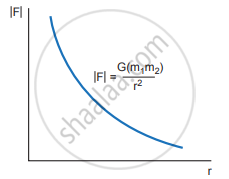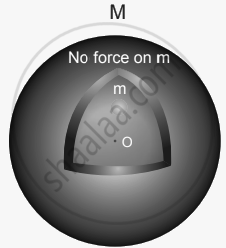Advertisements
Advertisements
प्रश्न
Discuss the important features of the law of gravitation.
उत्तर
1. As the distance between two masses increases, the strength of the force tends to decrease because of inverse dependence on r2. Physically it implies that the planet Uranus experiences less |F| gravitational force from the Sun than the Earth since Uranus is at a larger distance from the Sun compared to the Earth.
2. The gravitational forces between two particles always constitute an action-reaction pair. It implies that the gravitational force exerted by the Sim on the Earth is always towards the Sun. The reaction force is exerted by the Earth on the Sun. The direction of this reaction force is towards Earth.

Variation of gravitational force with distance
3. The torque experienced by the Earth due to the gravitational force of the Sun is given by
`vecτ = vec"r" xx vec"F" = vec"r" xx (-("GM"_"S""M"_"E")/"r"^2 hat"r") = 0`
Since `vec"r" = "r", hat"r", (hat"r" xx hat"r") = 0`
So `vecτ = ("d" vec"L")/"dt" = 0`
It implies that angular momentum `vec"L"` is a constant vector.


Hollow sphere of mass
4. The expression `vec"F" = -("GM"_1"M"_2)/"r"^2 hat"r""` has one inherent assumption that both M1, and M2 are treated as point masses. When it is said that Earth orbits around the Sun due to Sun’s gravitational force, we assumed Earth and Sun to be point masses.
5. Point masses hold even for a small distance.
6. There is also another interesting result. Consider a hollow sphere of mass M. If we place another object of mass ‘m’ inside this hollow sphere the force experienced by this mass ‘m’ will be zero.
APPEARS IN
संबंधित प्रश्न
The gravitational potential due to the Earth is minimum at _______.
According to Kepler’s second law, the radial vector to a planet from the Sun sweeps out equal areas in equal intervals of time. This law is a consequence of ___________.
State Newton’s Universal law of gravitation.
Explain how Newton verified his law of gravitation.
Assume that you are in another solar system and provided with the set of data given below consisting of the planets’ semi-major axes and time periods. Can you infer the relation connecting semi-major axis and time period?
| Planet (imaginary) | Time period (T) (in year) | Semi-major axis (a) (in AU) |
| Kurinji | 2 | 8 |
| Mullai | 3 | 18 |
| Marutham | 4 | 32 |
| Neithal | 5 | 50 |
| Paalai | 6 | 72 |
If the masses and mutual distance between the two objects are doubled, what is the change in the gravitational force between them?
Suppose unknowingly you wrote the universal gravitational constant value as G = 6.67 × 1011. instead of the correct value, G = 6.67 × 10−11, what is the acceleration due to gravity g' for this incorrect G? According to this new acceleration due to gravity, what will be your weight W'?
The escape velocity of a body depends upon mass as ______
The mass density of a spherical galaxy varies as `"K"/"r"` over a large distance 'r' from its center. In that region, a small star is in a circular orbit of radius R. Then the period of revolution, T depends on R as :
Four identical particles of mass M are located at the corners of a square of side 'a'. What should be their speed if each of them revolves under the influence of the other's gravitational field in a circular orbit circumscribing the square?

